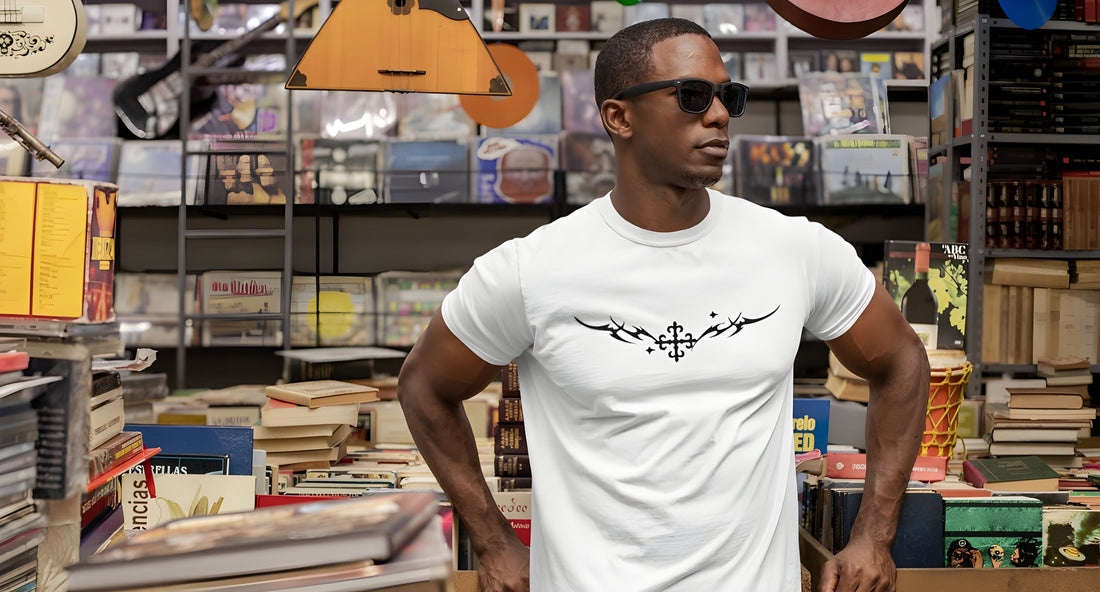
The Timeless Appeal of the T-Shirt: From Basic Staple to Bold Statement
Share
The T-shirt — a simple piece of fabric with sleeves — has become one of the most iconic and versatile garments in modern fashion. From casual comfort wear to high-end street style, the T-shirt has evolved far beyond its humble beginnings. Today, it is not just a wardrobe essential but a powerful medium of expression, identity, and culture. In this article, we’ll explore the history, evolution, significance, and future of the T-shirt — a timeless garment that continues to reinvent itself across generations.
A Brief History of the T-Shirt
The origins of the T-shirt date back to the early 20th century. Originally used as an undergarment by the U.S. Navy in the 1910s, it quickly became popular among workers for its lightweight and breathable design. It wasn’t until the 1950s, however, that the T-shirt began to emerge as a standalone piece of fashion, largely thanks to Hollywood. Icons like Marlon Brando in A Streetcar Named Desire and James Dean in Rebel Without a Cause made the T-shirt a symbol of rebellion and youth.
The T-shirt’s simple construction — a crew or V-neck, short sleeves, and a straight cut — allowed for easy manufacturing and widespread popularity. What once was a functional layer beneath uniforms turned into a cultural canvas.
From Blank Canvas to Cultural Billboard
As printing technology evolved, so did the T-shirt’s ability to carry messages. In the 1960s and ‘70s, T-shirts became a staple of counterculture movements. Activists, musicians, and artists used them to spread messages, slogans, and political statements. From “Make Love, Not War” to band logos and protest art, the T-shirt became an emblem of personal belief and freedom of expression.
In the 1980s and ‘90s, graphic tees became a powerful marketing tool for brands, musicians, and designers. Logos, pop culture references, and custom designs turned T-shirts into wearable art. Whether supporting a cause, promoting a band, or simply showing off personal style, the T-shirt became a language of its own.
T-Shirts in Fashion Today
Today, the T-shirt is a fashion staple found in nearly every closet around the world. Its versatility knows no bounds — it pairs effortlessly with jeans, can be tucked into a skirt for a polished look, layered under a blazer for smart-casual appeal, or worn oversized for a streetwear vibe.
Designers and fashion houses have embraced the T-shirt as both a basic and a statement piece. High-end brands like Balenciaga, Off-White, and Gucci have all created limited-edition T-shirts that sell for hundreds of dollars. Meanwhile, affordable fashion retailers continue to innovate with bold prints, eco-conscious fabrics, and size-inclusive cuts.
Why T-Shirts Remain Popular
There are several reasons why T-shirts have stood the test of time:
1. Comfort and Functionality
T-shirts are easy to wear, breathable, and perfect for everyday use. Whether cotton, organic blends, or moisture-wicking synthetics, the T-shirt is designed for comfort.
2. Affordability
T-shirts are generally budget-friendly, making them accessible to a wide range of consumers. You can buy a basic tee for a few dollars or splurge on a designer version — either way, you’re investing in a universal staple.
3. Customization
T-shirts are one of the most customizable clothing items. From screen printing to embroidery, dyeing, and patchwork — creativity knows no limits. This is why T-shirts are so popular in branding, events, and personal fashion statements.
4. Expression of Identity
Whether it’s your favorite band, a slogan you believe in, or a piece of art you connect with, T-shirts are a canvas for personal expression. They reflect personality, mood, and cultural affiliations.
T-Shirts and Streetwear Culture
Streetwear has elevated the T-shirt to cult status. Brands like Supreme, Stüssy, BAPE, and Travis Scott’s Cactus Jack have turned limited-edition T-shirts into collectibles. In streetwear, drops are timed events, and T-shirts sell out within minutes, often reselling for three or four times the original price.
The hype around streetwear tees demonstrates the T-shirt’s role in building community, exclusivity, and cultural significance. It’s no longer just about what you wear — it’s about what you represent.
Sustainability and the Future of the T-Shirt
As the fashion industry reckons with its environmental impact, the T-shirt is evolving yet again. Sustainable materials like organic cotton, bamboo, hemp, and recycled fabrics are being used to produce eco-friendly T-shirts. Many brands are also adopting ethical labor practices and transparent supply chains.
Slow fashion and conscious consumerism are encouraging buyers to choose quality over quantity. Today’s T-shirt wearer is more informed and values durability, ethics, and environmental responsibility.
How to Style a T-Shirt for Every Occasion
The beauty of the T-shirt lies in its adaptability. Here are a few ways to style a tee for different vibes:
- Casual: Pair with jeans, joggers, or shorts. Add sneakers and a cap for a laid-back look.
- Smart Casual: Tuck into chinos or a skirt and throw on a blazer or denim jacket.
- Streetwear: Go oversized, layer with a flannel or puffer, and accessorize with chunky sneakers and chains.
- Workwear: Opt for a plain or subtly patterned tee under a suit or cardigan.
- Loungewear: Match with comfy sweatpants or leggings — perfect for working from home or chilling out.
Conclusion
From its origins in military uniforms to becoming the backbone of modern style, the T-shirt is much more than a piece of clothing. It’s a symbol of comfort, culture, creativity, and change. Whether worn plain, printed, cropped, oversized, or layered — the T-shirt is a fashion chameleon that continues to redefine itself.
In a world that’s constantly changing, one thing remains clear: the T-shirt isn’t going anywhere. It’s a blank slate, a voice, a vibe — and perhaps the most powerful piece of fabric in your wardrobe.
